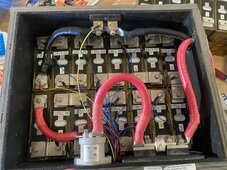Checking over my own system today,
It was a good day for this, solar was excellent and the PV was over 9kW for several hours.
I figured, well lets try a few things and 'see what happens'
First up, I checked how the incoming PV power was being shared between all the packs - checked out nearly equal, 168A incoming, approx 27A on each of 7 packs.
Okay, well what if some packs were to drop out?
I have DC breakers between each pack and my main copper bus bars on the ESS, so I shut one pack down. The others picked up the additional current.
Okay how about 'trip' a few more,
Current increased on the remaining packs.
When I had only two packs online, and all the others off, the current was nearly 85 Amps on each of those two remaining 16s packs. Everything was fine, I had the laser temperature meter - terminals warm but not hot. okay let's see what happens with just ONE pack.
I flipped the breaker on the second-last pack, and the only remaining pack on-line now was going to see 168A ...
"Click" - the BMS shut down charging on overcurrent (my BMS's are all 100A). Interestingly, I have 125A DC breaker between the ESS bus POS and the pack - it didn't trip.
Each pack also has it's own 2P 125 DC breakers, and that didn't trip either. I think the BMS is faster-acting in this situation, since the breaker would take time to heat up under the excessive current, but the BMS is nearly instant.
Anyway the JK did it's job, and shut off on over-current.
So with the final pack shut-down by the BMS, this cut the battery power to my inverters, they need battery 'available' so they shut off on a 'low battery' fault. Leaving me standing in the dark - except for the light from a nearby window LOL.
Restarted everything, all was fine, running normally as usual.
Excess current doesn't cause any harm, if the BMS does it's job. If not, the breaker should trip and cut off the current, but only if the breaker is sized correctly. Looking at a trip curve, it could take considerable time for my 125A breakers to trip with 168A current.
I wonder what the OP's breakers were rated for, and if this perhaps lead to the dominos falling - overheated cables short to the edge of the shelf-angle leading to heating up and fire, venting the cells that then also catch fire, collapse the shelf leading to the broken shunt and other damage we see.





